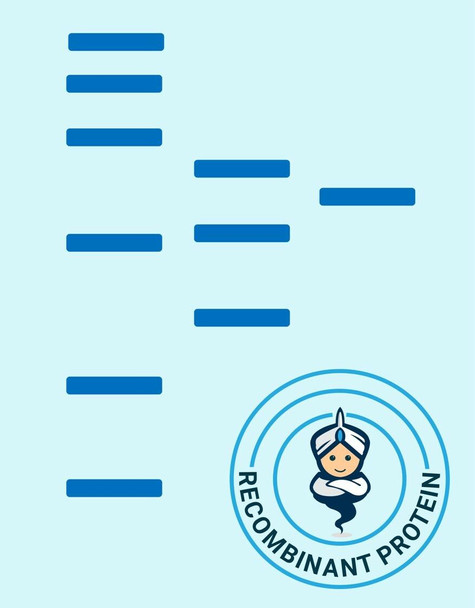Description
| Product Name: | Mouse CXCL16 Recombinant Protein |
| Product Code: | RPPB1114 |
| Size: | 25µg |
| Species: | Mouse |
| Target: | CXCL16 |
| Synonyms: | C-X-C motif chemokine 16, Small-inducible cytokine B16, Transmembrane chemokine CXCL16, Scavenger receptor for phosphatidylserine and oxidized low density lipoprotein, SR-PSOX, Cxcl16, Srpsox, Zmynd15, AV290116, BB024863, 0910001K24Rik. |
| Source: | Escherichia Coli |
| Physical Appearance: | Sterile Filtered White lyophilized (freeze-dried) powder. |
| Formulation: | The protein was lyophilized from a concentrated (1.0mg/ml) solution in 20mM PB, pH 7.4, 50mM NaCl. |
| Solubility: | It is recommended to reconstitute the lyophilized CXCL16 Mouse in sterile 18M?-cm H2O not less than 100�g/ml, which can then be further diluted to other aqueous solutions. |
| Stability: | Lyophilized CXCL16 although stable at room temperature for 3 weeks, should be stored desiccated below -18°C. Upon reconstitution CXCL16 should be stored at 4°C between 2-7 days and for future use below -18°C.For long term storage it is recommended to add a carrier protein (0.1% HSA or BSA).Please prevent freeze-thaw cycles. |
| Purity: | Greater than 97.0% as determined by:(a) Analysis by RP-HPLC.(b) Analysis by SDS-PAGE. |
| Amino Acid Sequence: | NQGSVAGSCS CDRTISSGTQ IPQGTLDHIR KYLKAFHRCP FFIRFQLQSK SVCGGSQDQW VRELVDCFER KECGTGHGKS FHHQKHLP |
| Biological Activity: | Determined by its ability to chemoattract murine lymphocytes using a concentration range of 100-1000ng/ml corresponding to a Specific Activity of 1,000-10,000IU/mg. |
Mouse CXCL16 is a nonELR motif including CXC chemokine with a transmembrane domain. Mouse CXCL16 cDNA encodes a 246 a.a. precursor protein with a putative 26 a.a. residue signal peptide, an 88 a.a. residue chemokine domain, an 87 a.a. residue mucinlike spacer region, a 22 a.a. residue transmembrane domain, and a 23 a.a. residue cytoplasmic tail. CXCL16 induces a strong chemotactic response and calcium mobilization. Furthermore, CXCL16 acts as a scavenger receptor on macrophages, which specifically binds to OxLDL (oxidized low density lipoprotein), suggesting that it may be involved in pathophysiology such as atherogenesis. Mouse CXCL16 is generated by dendritic cells in lymphoid organ T cell zones as well as by cells in the splenic red pulp both as membranebound and soluble forms. CXCR6/Bonzo (STRL33 and TYMSTR) is the receptor for CXCL16. CXCL16 is expressed in the spleen, lymph nodes, and Peyer patches. It is also expressed in non-lymphoid tissues such as lung, kidney, small intestine, and thymus, with weak expression in heart and liver and no expression in brain and purified B- and T-cells.CXCL16 deficiency is linked to breast cancer progression. In addition, CXCL16 is involved in immunological liver injury by regulating T lymphocyte infiltration in liver tissue. Furtheremore, CXCL16 has a distinctive role in the maintenance of cardiac allograft tolerance mediated by natural killer T cells. Moreover, CXCL16 has a significant role in not only the production of IFN-gamma by NKT cells, but also promotion of Th1-inclined immune responses mediated by NKT cells.
CXCL16 Mouse Recombinant produced in E.Coli is a single, non-glycosylated, polypeptide chain containing 88 amino acids and having a molecular mass of 9.9kDa. The CXCL16 is purified by proprietary chromatographic techniques.
| UniProt Protein Function: | CXCL16: Acts as a scavenger receptor on macrophages, which specifically binds to OxLDL (oxidized low density lipoprotein), suggesting that it may be involved in pathophysiology such as atherogenesis. Induces a strong chemotactic response. Induces calcium mobilization. Binds to CXCR6/Bonzo. Belongs to the intercrine alpha (chemokine CxC) family. |
| UniProt Protein Details: | Protein type:Membrane protein, integral Cellular Component: extracellular space; membrane; integral to membrane Molecular Function:low-density lipoprotein receptor activity; chemokine receptor binding; chemokine activity; cytokine activity; scavenger receptor activity Biological Process: receptor-mediated endocytosis; response to cytokine stimulus; chemotaxis; lymphocyte chemotaxis; positive regulation of cell growth; positive regulation of cell migration |
| UniProt Code: | Q8BSU2 |
| NCBI GenInfo Identifier: | 37088434 |
| NCBI Gene ID: | 66102 |
| NCBI Accession: | Q8BSU2.2 |
| UniProt Secondary Accession: | Q8BSU2,Q3UD70, Q5F2D5, Q8VE25, Q9EPB3, |
| UniProt Related Accession: | Q8BSU2 |
| Molecular Weight: | 26,896 Da |
| NCBI Full Name: | C-X-C motif chemokine 16 |
| NCBI Synonym Full Names: | chemokine (C-X-C motif) ligand 16 |
| NCBI Official Symbol: | Cxcl16�� |
| NCBI Official Synonym Symbols: | SR-PSOX; Zmynd15; AV290116; BB024863; CXCL16v1; CXCL16v2; b2b498Clo; 0910001K24Rik�� |
| NCBI Protein Information: | C-X-C motif chemokine 16; SR-PSOX/CXCL16; Mutant line 498; Cxc chemokine ligand 16; small-inducible cytokine B16; transmembrane chemokine CXCL16; zinc finger, MYND-type containing 15; scavenger receptor for phosphatidylserine and oxidized low density lipoprotein |
| UniProt Protein Name: | C-X-C motif chemokine 16 |
| UniProt Synonym Protein Names: | Scavenger receptor for phosphatidylserine and oxidized low density lipoprotein; SR-PSOX; Small-inducible cytokine B16; Transmembrane chemokine CXCL16 |
| Protein Family: | C-X-C motif chemokine |
| UniProt Gene Name: | Cxcl16�� |
| UniProt Entry Name: | CXL16_MOUSE |









